This recipe celebrates the Makar Sankranti festival and is a traditional Bengali sweet delicacy. The harvest festival is popular across India and known by various names i.e. Bihu, Pongal, Uttarayan, Vishu and so on. The ingredients specially Rice and Jaggery celebrate the joy of the fresh harvest. My Bengali friends will relate to all the memories of their childhood when the elder women in the family prepared Pathishapta and various forms of Puli Pithe to spread the cheer. I certainly have very fond memories of my Grandmother’s freshly made goodies which were stored nicely in the wire mesh cabinets from where we shamelessly stole. If you do not have ready access to jaggery, you can replace it with sugar. One tip on the preparation, ensure that the filling of coconut and jaggery retains some moisture so it doesn’t breakdown easily when filling into the crepes. Keep a low flame right through the cooking of the crepe. This ensures the crepe takes on a light golden hue and doesn’t get burnt. Celebrate Makar Sankranti with Pathishapta and Pithe of your choice. Happy Fooding Around.
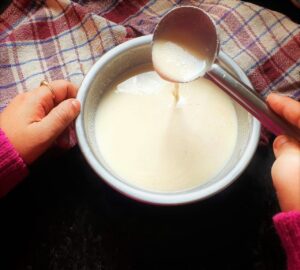
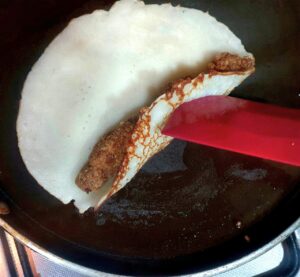
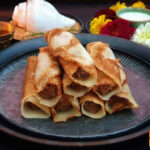
Patishapta Pithe (Cocunut Jaggery Crepe)
-
 Prep Time: 15 mins
Prep Time: 15 mins -
 Cook Time: 25 mins
Cook Time: 25 mins -
 Total Time: 40 mins
Total Time: 40 mins -
 Yield: 8 -10 1x
Yield: 8 -10 1x
Description
Sankranti Special Sweet
Ingredients
Ingredients for the Filling :
- 2 cups freshly grated or desiccated Coconut
- 3/4th cup Gur (Jaggery)
- ½ cup Sugar
- ½ Tsp Cardamon Powder
- ¼ cup Khowa
Ingredients for the Crepe Batter :
- 1 cup Maida (All Purpose Flour)
- ½ cup Sooji (Semolina)
- ¼ cup Rice Flour
- 1 Tbsp Sugar
- Some Oil or Ghee for pan frying
Instructions
Instruction for the Filling :
- Heat a large pan over medium flame. Add the freshly grated or desiccated coconut and dry roast for 2 to 3 mins over medium low flame.
- Add the jaggery and sugar to the pan. Stir continuously to mix the jaggery and sugar well and evenly with the coconut flakes. Be a little patient to allow the jaggery heat up and melt. Wait till the coconut jaggery mixture does not stick to the pan anymore.
- Next add the khoya and keep stirring constantly. Keep the flame to a medium low right through out. Stir and cook till the khoya is mixed in completely. Now increase the flame to a medium and cook for another 1 – 2 mins. Keep stirring vigorously, scraping the sides as well as the bottom of the pan.
- Switch off the flame and transfer to a plate too cool. It is preferred to have a moist filling as it will dry up when cooled. In fact a dry filling is totally avoidable, as it will not hold it’s shape when put as filling inside the crepes. Once cool take 2 Tsp of the filling at a time and shape them into separate round balls and then roll and flatten them into elongated shape.
Instruction for the Crepe or Patishapta :
- Grind the semolina to a coarse powder with the help of a grinder or food processor.
- Sieve and sift the flour in a deep bowl. Add the semolina, rice flour and sugar. Next pour the milk little by little to get a lump free, smooth, thick paste. Break the lumps if any by using spoons/fork or simply your hands.
- Once the batter is completely smooth without any lumps add more milk and mix well to form a more balanced batter. Let the batter mix sit for 2 hours.
- Heat a non-stick griddle or tava on a medium low flame. Smear lightly with a few drops of ghee or oil. Pour one ladle full of batter on the tava. Quickly rotate the batter to form a medium sized crepe. Keeping flame to a low, cook the crepe to a light golden brown.
- Allow to cook for 1 -2 mins before placing the coconut jaggery filling one per crepe at a time. Put the filling lengthwise towards one side of the crepe. Turn the edges inwards and roll the crepe along with the filling till it reaches the other end of the circular crepe. Press it gently to keep the patishapta and it’s filling in place.
- Remove the Patishapta from the tava and place it on a serving platter or dish. Repeat the above with the remaining batter and filling.
- Patishpata can be served either warm or cold. Goes very well with Nolen Gur or even with thick rich Rabri.
Notes
It is perfectly fine to have a moist filling as it will dry up when cooled. In fact a dry filling is totally avoidable, as it will not hold into shape when put as filling inside the crepes. If you are fond of raw coconut, you may even think of skipping the roasting of the grated coconut. Feel free to add more of the jaggery or sugar according to your preferred sweet intake.

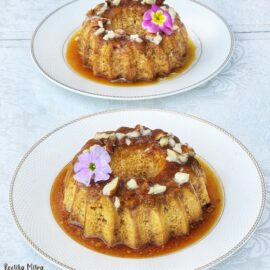

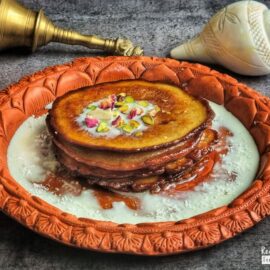
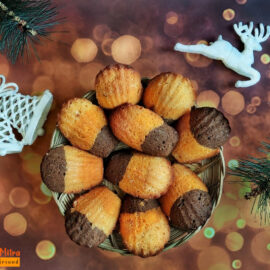
Leave a Reply